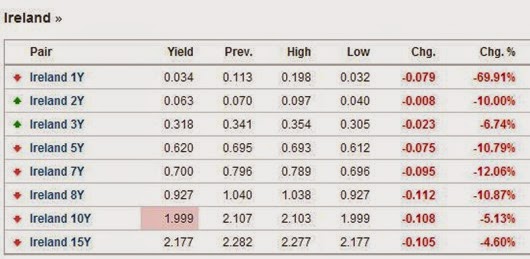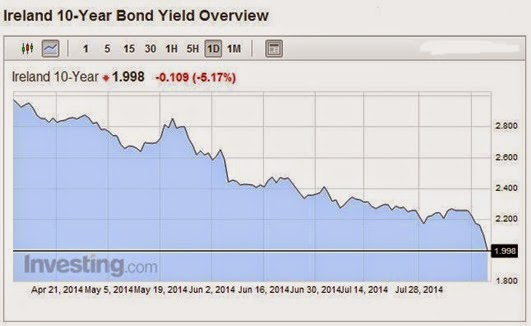The February 2013 liquidation of the IBRC resulted in the Central Bank of Ireland holding around €25 billion of Irish government bonds with maturities of between 25 and 40 years (there is also €3 billion of a 2025 bond that was used to finance the 2012 Promissory Note payment)
The drop in yields since then means that the market value of these is now likely to be above €25 billion. Since February 2013, for example, the 10-year yield on Irish government bonds has fallen from 3.8% to 1.9%. It would be useful to have a current estimate of the market value of these bonds held by the Central Bank but one does not appear to be available.
At the time of the transaction the following was included in a overview presentation published by the Department of Finance (slide 10):
The Central Bank of Ireland will sell the bonds but only where such a sale is not disruptive to financial stability. They have however undertaken that minimum of bonds will be sold in accordance with the following schedule: to end 2014 (€0.5bn), 2015-2018 (€0.5bn p.a.), 2019-2023 (€1bn p.a.), 2024 and after (€2bn p.a.).
A couple of days later the Governor of the Central Bank appeared on RTE’s The Week in Politics and said (from around 05:00):
The Central Bank of Ireland has undertaken to sell these bonds as soon as possible subject to financial stability conditions.
The 2013 Annual Report of the Central Bank contained the following about the €25 billion of Floating Rate Notes (FRNs) acquired by the Bank(footnote (i) to the table in page 123):
The Bank intends to sell the combined portfolio of the FRNs and the fixed rate bond as soon as possible, provided conditions of financial stability permit. The Bank will sell a minimum of these securities in accordance with the following schedule: to end 2014 (€0.5 billion), 2015-2018 (€0.5 billion per annum), 2019-2023 (€1 billion per annum), and 2024 on (€2 billion per annum until all bonds are sold). As part of these minimum sales, the Bank sold €350 million of the 5.4% Irish 2025 Government Bond by end December 2013.
In recent weeks there has been increased attention given to the early repayment of Ireland’s loans from the IMF. The possibility of this has been discussed here for a while. Recently the Minister for Finance indicated that the annual interest savings from the early repayment of €15 billion of the IMF loans could be around €375 million. It seems that attempts will be made with the various EU creditors (requiring getting the agreement of all other Member States) to allow the early repayment of two-thirds of Ireland’s IMF loans.
It appears Ireland is in a position to repay €15 billion of IMF loans, presumably by issuing replacement debt. It is not clear that agreement will be reached to do this. If we have the financial wherewithal to refinance the IMF loans who is to say that the Central Bank of Ireland would not be able to sell €25 billion of government bonds, or say two-thirds of them, without being “disruptive to financial stability”?
It is worth repeating that the 2013 Annual Report of the ECB included the following (page 110):
The liquidation of the Irish Bank Resolution Corporation (IBRC) raises serious monetary financing concerns. These concerns could be somewhat mitigated by the disposal strategy of the Central Bank of Ireland.
Indeed. We might gain a couple of hundred million from reduced interest payments by the Exchequer on the IMF loans but maybe that only rises the possibility that we could lose a couple of hundred million from reduced payments into the Exchequer Account from the Central Bank surplus.
There has been little to indicate do far that these two sub-plots of Ireland’s government debt are linked but with many moving parts it can be unwise to try and look at different things in isolation.
Tweet



